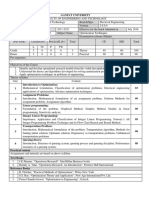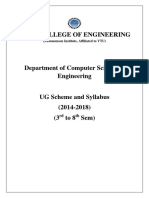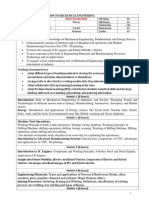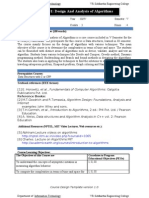CSEN3001 Syllabus
CSEN3001 Syllabus
Uploaded by
Ajitesh SinghCopyright:
Available Formats
CSEN3001 Syllabus
CSEN3001 Syllabus
Uploaded by
Ajitesh SinghCopyright
Available Formats
Share this document
Did you find this document useful?
Is this content inappropriate?
Copyright:
Available Formats
CSEN3001 Syllabus
CSEN3001 Syllabus
Uploaded by
Ajitesh SinghCopyright:
Available Formats
Department of Computer Science and Engineering
L T P S J C
CSEN3001 DESIGN AND ANALYSIS OFALGORITHMS
3 0 0 0 0 3
Pre-requisite CSEN2001 : Data Structures
Co-requisite None
Course Description:
This course enables the students to gain knowledge in various techniques of designing algorithms,
estimating the efficiency of the developed algorithms in terms of time and space. The knowledge
gained in this course can be applied to the latest developments in technology.
Course Educational Objectives:
• Explain the asymptotic performance of algorithms.
• Demonstrate the complexity of an algorithm in terms of time and space.
• Help to design and implement programs in various programming paradigms.
• Familiarize with efficient algorithms in software design and development.
UNIT 1 Introduction to Algorithms 9 hours
Algorithm specification, Performance Analysis. Divide and Conquer: The general method: Binary
search, finding maximum and minimum, Merge sort, Quick sort, Selection, Strassen’s Matrix
multiplication.
UNIT 2 The Greedy Method 9 hours
The general method, Knapsack problem, Job sequencing with deadlines, optimal storage on
tapes, minimum cost spanning trees, single source shortest paths.
UNIT 3 Dynamic Programming 9 hours
The general method, multistage graphs, all pairs shortest paths, optimal binary search trees,
reliability design, the travelling sales person problem.
UNIT 4 Basic search and traversing techniques 9 hours
Techniques for Binary trees, Techniques for Graphs, connected components and spanning trees,
Bi-connected components, and depth first search. Back Tracking: The General Method,
Eight Queens problem, Sum of subsets, Graph coloring, Hamiltonian cycle.
Department of Computer Science and Engineering
UNIT 5 Branch and Bound & Algebraic Problems 9 hours
Branch and Bound: The method, traveling sales person problem, 0/1 knapsack problem,
efficiency considerations. Algebraic Problems: The general method, Evaluation and
Interpolation.
TextBooks:
1. Ellis Horowitz, S. Sahni, Fundamentals of Computer Algorithms, 2/e, University Press, 1984.
2. Thomas H. Cormen, Charles E. Leiserson, Introduction to Algorithms, et.al., 3/e, MIT
Press,2012.
References:
1. Aho, Hopecraft, Ullman, The Design and Analysis of Computer Algorithms, 1/e, 2002.
2. Michel T. Goodrich & Roberto Tamassia, Algorithm Design: Foundations, Analysis, and
InternetExamples, 1/e, John Weily and Sons, 2001.
3. Sara Baase, Allen Van Gelder, Computer Algorithms: Introduction to Design and Analysis,
3/e,Pearson Education, 1999.
4. Mark Allen Weiss, Data Structures and Algorithm Analysis in JAVA, 3/e, Pearson
Education,2011.
5. Jon Kleinberg, Eva Tardos, Algorithm Design, 1/e, Pearson, 2013.
Course Outcomes:
After successful completion of the course the student will be able to:
1. Apply concepts of mathematics to find space and time complexities of various algorithms
2. Analyze the problems that can be solved by using Divide and Conquer and Greedy Method
3. Analyze the problems that can be solved by using Dynamic Programming
4. Analyze the problems that can be solved by using Backtracking and Branch and Bound methods
5. Apply various design techniques to solve any real-world problems.
CO-PO Mapping:
PO1 PO2 PO3 PO4 PO5 PO6 PO7 PO8 PO9 PO10 PO11 PO12 PSO1 PSO2 PSO3
CO1 3 1 1 1 1 1 3 3
CO2 1 2 3 1 1 1 1 1 1 3
CO3 1 2 3 1 1 1 2 3
CO4 2 2 3 1 1 1 1 2 3
CO5 3 2 3 1 1 1 1 2 3
APPROVED IN:
BOS : 06-09-2021 ACADEMIC COUNCIL: 22nd AC (01-04-2022)
You might also like
- Yamaha FZ CatalogueDocument55 pagesYamaha FZ CatalogueAnonymous KoA00wXXD81% (79)
- Hunter The Reckoning - 2 Page Character SheetDocument2 pagesHunter The Reckoning - 2 Page Character SheetConsignmenttoduat0% (1)
- Instillation Guide 1Document145 pagesInstillation Guide 1aassasNo ratings yet
- Multisim Tutorial & Assignment May2019 AmendedDocument15 pagesMultisim Tutorial & Assignment May2019 AmendedShan PinNo ratings yet
- Arabic With Husna (Lesson 3) Unit 1 (1.1) Bayyinah TV Transcript NotesDocument5 pagesArabic With Husna (Lesson 3) Unit 1 (1.1) Bayyinah TV Transcript NotesMUSARRAT BANO100% (6)
- MM - B412, B432, B512, MB472, MB492, MB562, ES4132, ES4192, ES5112, ES5162 (Option Tray) - 1Document18 pagesMM - B412, B432, B512, MB472, MB492, MB562, ES4132, ES4192, ES5112, ES5162 (Option Tray) - 1Vitalij KrivenNo ratings yet
- Daa (Csen3001)Document3 pagesDaa (Csen3001)Shiva ChandraNo ratings yet
- DAA NotesDocument161 pagesDAA NotesasminumdeepmathematicsNo ratings yet
- Daa 2019 SyllabusDocument3 pagesDaa 2019 Syllabusmemoriesbringback121No ratings yet
- Lab Manual FEB 9Document67 pagesLab Manual FEB 9kingraajaNo ratings yet
- Advanced AlgorithmsDocument72 pagesAdvanced Algorithmspallavagt2232No ratings yet
- DAA SylklasDocument3 pagesDAA Sylklas2023bardaiNo ratings yet
- Staff Copy-AlgorithmDocument65 pagesStaff Copy-Algorithm21cs105No ratings yet
- Daa Unit 3 Digital NotesDocument78 pagesDaa Unit 3 Digital Notes23102208No ratings yet
- Inter Departmental Electives 2022-24 SchemeDocument9 pagesInter Departmental Electives 2022-24 Schemeayush222125No ratings yet
- Syllabus B Tech CSE 3rd Year (6th Sem Non-Credit Based) KUKDocument10 pagesSyllabus B Tech CSE 3rd Year (6th Sem Non-Credit Based) KUKz1111234No ratings yet
- COMPUTER-NETWORKS-CourseFile 28 11 2022Document10 pagesCOMPUTER-NETWORKS-CourseFile 28 11 2022pvssivaprasadcseNo ratings yet
- 3rd SyllabusDocument27 pages3rd SyllabusthegreatarshiyaNo ratings yet
- Daa Cif 2024Document5 pagesDaa Cif 202423ucs649No ratings yet
- Study Plan EE-221 Digital Logic DesignDocument5 pagesStudy Plan EE-221 Digital Logic Designnauman yasinNo ratings yet
- MCA Syllabus - 1st Sem PDFDocument32 pagesMCA Syllabus - 1st Sem PDFshatabdi mukherjeeNo ratings yet
- 2EE71OE3 - Optimization TechniquesDocument2 pages2EE71OE3 - Optimization TechniquesVinod RajNo ratings yet
- Unit I Daa LM CseDocument31 pagesUnit I Daa LM CsefptobbxozqxyjvdfhaNo ratings yet
- IT Curriculum - SEM4Document13 pagesIT Curriculum - SEM4vidihac283No ratings yet
- Cse Ug Syllabus 2014 2018Document168 pagesCse Ug Syllabus 2014 2018Aishwarya PuriNo ratings yet
- CSE2002 Data - Structures - and - Algorithm - BL2023241000790 - CCM - DR Dheresh SoniDocument57 pagesCSE2002 Data - Structures - and - Algorithm - BL2023241000790 - CCM - DR Dheresh SoniDheresh SoniNo ratings yet
- 2018 7TH Sem Elective Stream 1Document11 pages2018 7TH Sem Elective Stream 1Aman SinghNo ratings yet
- Machine LearningDocument2 pagesMachine LearningRamesh MallaiNo ratings yet
- OptimizationDocument2 pagesOptimizationsiddhardha9010No ratings yet
- Wa0003.Document309 pagesWa0003.chirag suresh chiruNo ratings yet
- SyllabusDocument4 pagesSyllabuspolumanohar6No ratings yet
- DPSD Course File Up PDFDocument365 pagesDPSD Course File Up PDFVINOD DNo ratings yet
- EC4002 - Digital Logic DesignDocument5 pagesEC4002 - Digital Logic DesignTarangNo ratings yet
- Updated Course Outline EE 221 - Digital - Logic - Design - Spring - 2023Document9 pagesUpdated Course Outline EE 221 - Digital - Logic - Design - Spring - 2023Laiqa AliNo ratings yet
- Femcourse FileDocument11 pagesFemcourse FileRaja RamNo ratings yet
- After Modifications (WB - ALGORITHMS - 2018-19 (1) 550amHRS)Document80 pagesAfter Modifications (WB - ALGORITHMS - 2018-19 (1) 550amHRS)Uma MaheshNo ratings yet
- ME8791 Mechatronics Course FileDocument22 pagesME8791 Mechatronics Course FileRajasekaran R100% (1)
- OOAD Unit 3Document112 pagesOOAD Unit 3ADUSUMALLI LAKSHMI PRIYANo ratings yet
- 5th Sem Syllabus Iem 2023Document17 pages5th Sem Syllabus Iem 2023ransom3009No ratings yet
- AML - Theory - Syllabus - Chandigarh UniversityDocument4 pagesAML - Theory - Syllabus - Chandigarh UniversityMohd YusufNo ratings yet
- Design and Analysis of Algorithms ChoDocument12 pagesDesign and Analysis of Algorithms ChodivyaamshNo ratings yet
- Aditya Institute of Technology and Management: TekkaliDocument64 pagesAditya Institute of Technology and Management: Tekkalichalapathit520No ratings yet
- ADS Lecture Plan 2022 23 ODDDocument6 pagesADS Lecture Plan 2022 23 ODD1SI20CS116 - Sunil Kumar B ANo ratings yet
- DBMS LabDocument58 pagesDBMS Labmahedi.hassanNo ratings yet
- Lab1Document15 pagesLab1Kushal VithalNo ratings yet
- CE5602 Chapter 1 Introduction 2023Document35 pagesCE5602 Chapter 1 Introduction 2023Akila Tharanga LiyanarachchiNo ratings yet
- Switching Theory and Logic Design PDFDocument165 pagesSwitching Theory and Logic Design PDFmarcopolomoNo ratings yet
- BESCK104DDocument4 pagesBESCK104DNithin Gowdru0% (1)
- Daa Lab ManualDocument60 pagesDaa Lab ManualHirdesh SharmaNo ratings yet
- Course File: "Digital Communications"Document15 pagesCourse File: "Digital Communications"annam karthikNo ratings yet
- AA Lab Manual Session 2022-23Document33 pagesAA Lab Manual Session 2022-23Aditya PugaliaNo ratings yet
- Ai CifDocument3 pagesAi CifHAQNo ratings yet
- M.L.CSE SyllabusDocument3 pagesM.L.CSE SyllabusnawazNo ratings yet
- AboutDocument2 pagesAboutjoyaljms98No ratings yet
- Data Engineering LabDocument55 pagesData Engineering LabMAHAMMAD ILIYASNo ratings yet
- Machine Design - I COPODocument5 pagesMachine Design - I COPOrajdecoratorsNo ratings yet
- Operations Research Outline UpdatedDocument8 pagesOperations Research Outline UpdatedSAURAV SINGH 22GSOB2010246No ratings yet
- Data Structures SyllabusDocument2 pagesData Structures Syllabusshift2cs22No ratings yet
- CSE373 Algorithms Course OutlineDocument7 pagesCSE373 Algorithms Course OutlineMahbub KousarNo ratings yet
- 18IPOEDocument2 pages18IPOEGyanchand tilekarNo ratings yet
- Btech Cse Curriculum N Syllabus 2015 RMPDocument99 pagesBtech Cse Curriculum N Syllabus 2015 RMPSRM e-LearningNo ratings yet
- PYTHON PROGRAMMING-CourseFile 05 09 2022Document11 pagesPYTHON PROGRAMMING-CourseFile 05 09 2022pvssivaprasadcseNo ratings yet
- 21BCA2T463Document4 pages21BCA2T463AJ MOVIE ZONENo ratings yet
- DAA Course FileDocument6 pagesDAA Course FileJaya VakapalliNo ratings yet
- Computational Geometry: Exploring Geometric Insights for Computer VisionFrom EverandComputational Geometry: Exploring Geometric Insights for Computer VisionNo ratings yet
- Distributed Algorithms, second edition: An Intuitive ApproachFrom EverandDistributed Algorithms, second edition: An Intuitive ApproachRating: 4 out of 5 stars4/5 (5)
- WWW - Physics.ox - Ac.uk - Olympiad - Downloads - PastPapers - BPhO - Round - 1 - PRT - 1 - 2014 PDFDocument7 pagesWWW - Physics.ox - Ac.uk - Olympiad - Downloads - PastPapers - BPhO - Round - 1 - PRT - 1 - 2014 PDFMadAm JaJaNo ratings yet
- Taller 3 - Sistemas NumericosDocument15 pagesTaller 3 - Sistemas NumericosJulian CamargoNo ratings yet
- PreDefense (201 15 13919)Document18 pagesPreDefense (201 15 13919)Shamim NahidNo ratings yet
- Mining Frequent Patterns, Association and CorrelationsDocument42 pagesMining Frequent Patterns, Association and CorrelationsSudha PatelNo ratings yet
- NPX PPT NewDocument17 pagesNPX PPT NewYuvansh VermaNo ratings yet
- Champion Log Splitter 22tonDocument25 pagesChampion Log Splitter 22tonChuck CharlesNo ratings yet
- BTY79 SeriesDocument4 pagesBTY79 SeriesAmanda BentoNo ratings yet
- ELTE2.3 DBS3900 LTE TDD Basic Feature DescriptionDocument92 pagesELTE2.3 DBS3900 LTE TDD Basic Feature DescriptioneuniceikaNo ratings yet
- Iso Tank ContainersDocument13 pagesIso Tank ContainersMuslimah100% (1)
- Citra Log - Txt.oldDocument2 pagesCitra Log - Txt.oldNsiqnqbdjwnqNo ratings yet
- Elka Telkom Week 2Document48 pagesElka Telkom Week 2AzHar HrNo ratings yet
- IMUN Internship - General InformationDocument11 pagesIMUN Internship - General InformationTamim HossenNo ratings yet
- Screenshot 2023-11-04 at 4.45.16 PMDocument1 pageScreenshot 2023-11-04 at 4.45.16 PMABHINAV SINGHNo ratings yet
- Thermodynamics PreliminaryDocument3 pagesThermodynamics PreliminarySatoru FujinumaNo ratings yet
- Week 4 Ethical Decision Making ProcessDocument16 pagesWeek 4 Ethical Decision Making Processapi-3709645No ratings yet
- BMCC Syllabus Spring 2010Document3 pagesBMCC Syllabus Spring 2010eharte1445No ratings yet
- Altivar 16 ManualDocument33 pagesAltivar 16 Manualpromatis5746100% (1)
- 3 Ketu (South Node) Rahu (North Node) Life Learning in AstrologyDocument4 pages3 Ketu (South Node) Rahu (North Node) Life Learning in AstrologyRahulshah1984No ratings yet
- Cubesat Lidar Concepts For Ranging Topology Sample Capture SurDocument7 pagesCubesat Lidar Concepts For Ranging Topology Sample Capture SurKA LANo ratings yet
- Oracle 12.2 RAC Admin and Deploy GuideDocument459 pagesOracle 12.2 RAC Admin and Deploy Guidejordim_67No ratings yet
- Coursera LBKZQJAVS6B3 DiabetesDocument1 pageCoursera LBKZQJAVS6B3 DiabetesLuis EscudeiroNo ratings yet
- M Tech - Energy-Technology Course STR and SyllabusDocument1 pageM Tech - Energy-Technology Course STR and SyllabusAnkur MaheshwariNo ratings yet
- Bus Detection Device For The Blind Using RFID ApplicationDocument3 pagesBus Detection Device For The Blind Using RFID ApplicationRockHritikNo ratings yet
- 50 - 48 - Uc - Up - 25-90 PSDDocument7 pages50 - 48 - Uc - Up - 25-90 PSDdanielrosas17No ratings yet

























































































